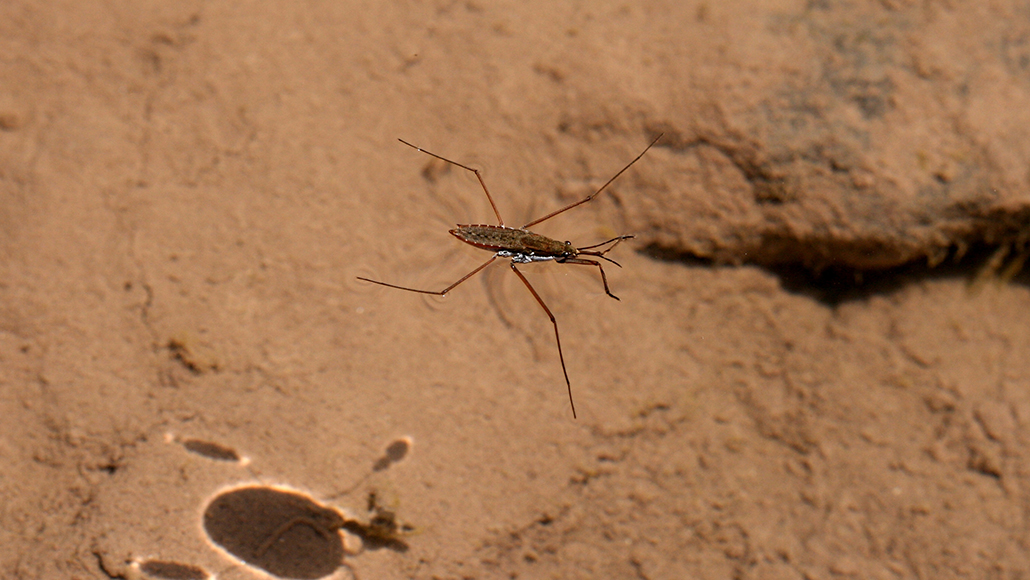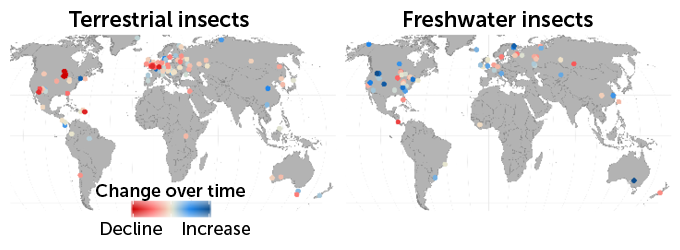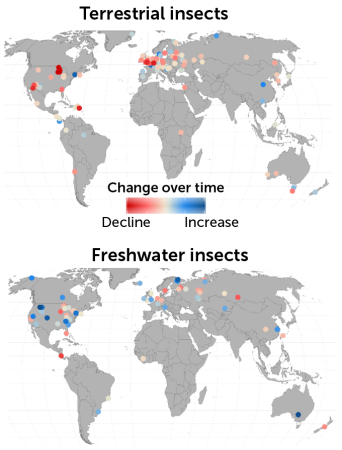The ‘insect apocalypse’ is more complicated than it sounds
Freshwater arthropods trended upward, while terrestrial ones declined, decades of data suggest

A new look at the so-called “insect apocalypse” finds a mix of local trends, including an uptick in the abundance of some freshwater insects like this water strider in North America.
Whitney Cranshaw, Colorado State University/Bugwood.org (CC BY 4.0)
Taking a big view of the so-called Insect Apocalypse finds some possible winners among the losers, plus a lot of things we don’t know yet.
Overheated end-times terms have popped up during the last few years conveying fear that the bounty of Earth’s butterflies, beetles, bees and many other insects has started slipping away. The worry is not just about species likely to go extinct. Even species that will probably survive might be shrinking in population so much that their skimpy numbers no can longer fill their current roles in ecosystems.
Now a new look at insect abundance, slanted toward North America and Europe, hints that freshwater residents are overall increasing. Data mostly gathered since the 1960s suggests that beetles, mayflies, dragonflies and other creatures that spend a good part of their lives in water have increased about 11 percent per decade, says a study in Science April 24. In contrast, land-dwelling insects shrank in abundance by about 9 percent per decade, the study says.
“Insects will not disappear,” says coauthor Roel van Klink, an entomologist at the German Center for Integrative Biodiversity Research in Leipzig. He and colleagues found, however, “a lot of reason for concern” overall, he says.
Van Klink first started thinking about the project in 2017, when careful, long-term monitoring of the biomass of insects flying in 63 protected nature preserves in Germany had dropped more than 75 percent over 27 years. “I doubt that’s a general phenomenon,” van Klink remembers thinking. After two months without hearing about anybody else starting a worldwide search for data, he says he realized, “I’ve got do it.”
Van Klink and colleagues found 166 surveys of abundance (numbers of individuals and/or the absolute mass of insects and occasionally spiders mixed in) that ran for at least 10 years at 1,676 sites around the world. The oldest data went back to 1928, but data are most abundant from the 1980s. Researchers compared how steeply or gently the populations were falling and rising. Many of the sites already were affected heavily by humans when surveys began. For instance, he speculates that the rise in freshwater arthropod abundance may reflect some recovery as environmental laws improved water quality in the United States.
The rise and fall of insect abundance worldwide
Surveys (dots) lasting at least 10 years show a range of abundance trends (redder for steeper declines, blue for steeper increases). Overall, freshwater insects have been increasing, and terrestrial ones declining, but both trends are distorted by disproportionate amounts of data from North America.


Van Klink warns against a search for one big threat to explain the trends. Even if humans stopped using pesticides tomorrow, “there’s no evidence that insects would suddenly be alright,” he says. He reels off a list of other threats — habitat destruction or fragmentation, climate change, pesticides, urbanization, light pollution and so on — that may be important in some places.
The new paper’s search for studies and its strategies for mixing data from diverse sites seems “much more thorough and analytically thoughtful” than those of previous papers on insect decline, says Alison Johnston, a quantitative ecologist at the Cornell Lab of Ornithology. Still she cautions that the trends this paper sees are driven largely by the outsized share of data from North America. Pulling the continent out of the data cuts the decline about in half.
Van Klink agrees this kind of analysis needs data from more places. “In all of Africa, we have two datasets,” he says. There’s nothing from India, and Australia “is shockingly underrepresented.”
The paper bristles with other cautions about conclusions drawn from such geographically skewed and relatively recent information. The news that freshwater organisms have been thriving may cheer you up, but such waters represent only 2.49 percent of Earth’s land area. In another caveat, researchers point out that datasets from protected areas are more abundant in this new study than protected areas are on the ground, so surveys of life in those cushy conditions may have weakened any signals of decline in the overall study.
Even with all the caveats, van Klink sees a looming problem in the apparently mild decline the paper detected of around 1 percent a year. “This is not even something you would notice from year to year, because the insect population varies so much,” he says. “But after 30 years you will have lost a quarter of your insects.” Despite the need for clearer data on insect decline, “we definitely need to do something about it.”






